Trout Fishing In August: Guide Tips For Consistent Success
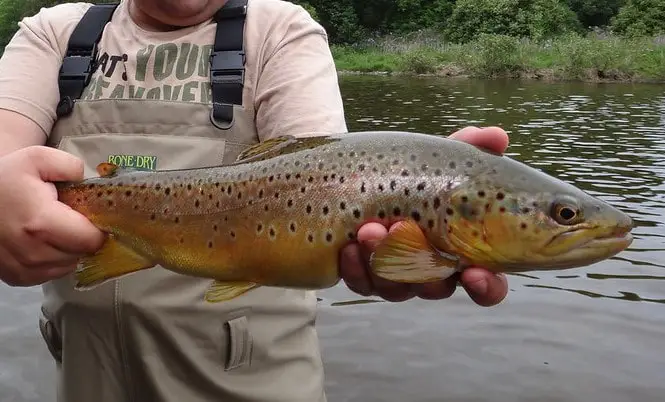
Trout fishing in August can be an excellent time to catch big trout. By understanding how to adapt to mid-summer river temperatures, bug hatches, and trout feeding and resting behaviors, I am able to consistently catch a lot of large trout.
Using my guide tips and tactics that I use to keep my customers catching big trout during the hottest month of the year, you can also see consistent success.
Key Takeaways
- Locations: Locate and fish the coldest water around. I discuss the areas I fish to find cold water that trout will stay active in.
- Best Time To Fish: I fish at times of the day when the air temps are coldest, like dawn, dusk, and in the dark. I also use a stream thermometer to determine when to fish and when to stop fishing.
- Methods: I use the right methods for the type of water, and I use longer fluorocarbon leaders for the low-clear waters that are common in the summer.
- Catch and Release: I use ethical and effective catch, handling, and releasing techniques to ensure all released trout survive.
Why Trout Fish In August In Rivers And Streams
- Rivers are less crowded during August, providing more space for fishing.
- Longer daylight hours allow for more fishing time before and after work. This means you won’t have to rush home from work.
- The weather is generally pleasant in the morning, which is the best time for trout fishing.
How Do High Temperatures Affect August Trout Fishing in Rivers
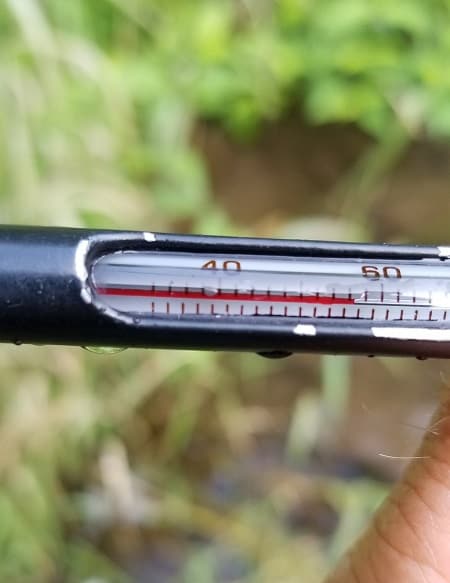
August is known for its high temperatures, especially in large cities where daily temperatures can reach 80 to 90 degrees Fahrenheit (27 to 32 degrees Celsius). During this time, water temperatures in rivers and streams typically range from 65 °F to 75 °F during the day.
However, some parts of rivers may remain colder. Fortunately, the water cools down at night, providing relief for trout.
Trout are generally less active during hot summer days. When water temperature exceeds 65 °F, brook, brown, and rainbow trout start to feel stressed. It is advisable to stop fishing for brown trout when the temperature reaches around 67°F to prevent harm to the fish.
High temperatures and low water flows lead to trout competing for space and food while feeling lethargic. It’s safe to say that this is not their preferred time of the year. Additionally, warm water has less oxygen, which results in trout having reduced energy and minimizing their activity, including feeding.
They tend to feed during specific times of the day and have shorter feeding windows. Prolonged high water temperatures can lead to starvation, organ damage, or even death for trout.
Despite these complex conditions, it doesn’t mean I avoid fishing during this thermally stressful period. By following the guidelines below, you can still enjoy trout fishing in the hottest weather, while minimizing harm to the fish you want to release.
While the water is cold enough for waders, some anglers choose to fish this time of year using the Wet Wading Method.
The Best Tips For Trout Fishing In August
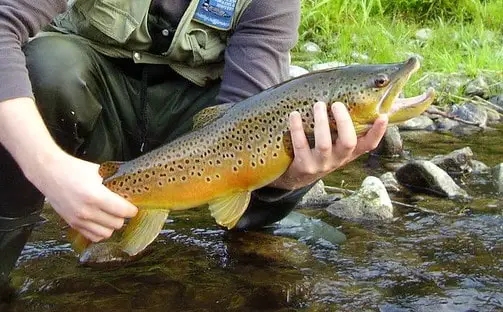
As an experienced fishing guide, I consistently catch large trout throughout the summer. The fact that these trout are caught and even grow larger in the fall proves that the proper handling and fishing methods work well.
Test The Water Temperatures Often
I regularly check the river temperatures and adjust my fishing technique accordingly.
Air temperatures can fluctuate significantly, ranging from 50 to 90 degrees on the same day in northern climates. Water temperatures also experience some fluctuation, albeit to a lesser extent.
To measure the water temperature, consider purchasing a small pocket stream thermometer.
Check the water temperature at least every hour from around 10 am on hot sunny days. If the temperature exceeds 67°F, it’s time to change strategies. It’s important to note that fishing at temperatures higher than 69°F becomes unethical if the plan is to release the trout since they are highly likely to die even with proper handling in these temps.
Find Colder Water
Once water temperatures reach 68°F, it’s worth looking for colder water where trout are still likely to be feeding. Upper sections of rivers and areas with spring upwellings often maintain lower temperatures. Spring water tends to be around 55°F, providing suitable conditions for trout.
Fish Spring Creeks
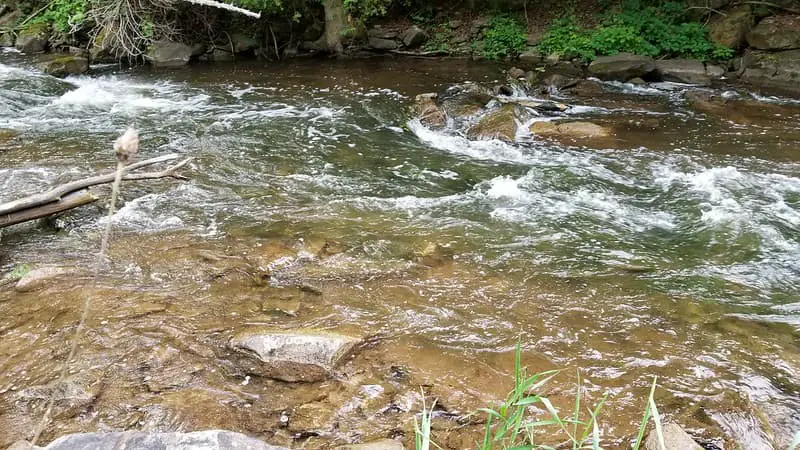
Opt for spring-fed streams and rivers at higher elevations that offer plenty of shade for mid-summer trout fishing. In August, trout tend to prefer moving water and deeper pools in spring creeks.
Fish Shaded and Forested Areas
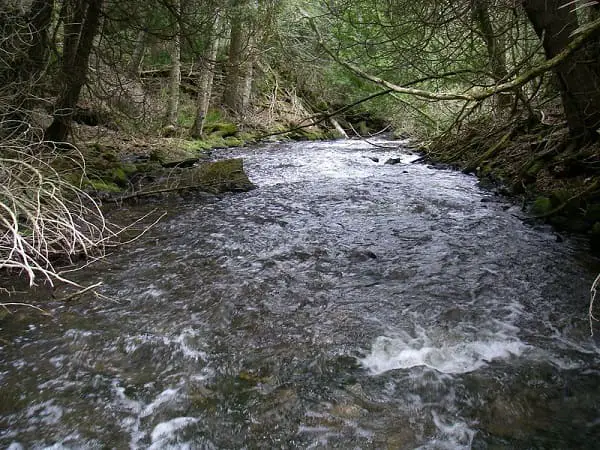
Avoid wide-open sections of lower rivers that heat up faster under the sun. Instead, focus on rivers and streams located in forests and valleys that provide natural shade.
These shaded areas help maintain cooler water temperatures and create more favorable fishing conditions.
Fish Tailwater Rivers
Consider fishing in tailwater rivers, which are sections of rivers below large dams with deep reservoirs.
The water released from these dams is often colder, providing suitable conditions for trout to thrive. Look for areas 15 to 30 miles below the dam where the water remains cool enough to catch trout in August or when the weather is hot.
You could also try fishing the reservoir itself.
Fish Select Spots
Trout seek out colder water during hot summer days. Look for specific spots where trout are likely to congregate:
- Fish big deep pools: Large deep pools with nearby groundwater can concentrate trout, especially larger ones.
- Fish rapids: Rapids maintain oxygen levels and attract trout seeking refuge in these areas.
- Fish in cold tributaries: Instead of focusing solely on the main river, explore smaller cold-water tributaries. Trout from the main river often move into these tributaries to escape the heat.
- Fish below cold water tributaries: A well-kept secret is to fish the main river where a cold tributary enters, or target the first few pools downstream.
- Waterfalls: Trout migrating upstream in search of cooler water can become trapped in the plunge pools of waterfalls. These areas are also rich in oxygen, making them ideal for trout fishing.
- Riffles and pocket water: These areas have increased oxygen content, making them attractive to trout.
Since these locations are limited during mid-summer, trout are more likely to be grouped in larger numbers, making them easier to target.
Fish Early: Fish at Dawn
Fishing early in the morning is a highly effective tactic for catching big trout in August. As daylight breaks, the water temperature cools off from the night, and trout become more active.
This early morning period is the most productive time for fishing and typically lasts 3 to 5 hours on local rivers. Take advantage of the cooler temperatures and heightened feeding activity during this time.
Fish at Dusk
If you’re not an early riser, consider fishing in the evening or even at night. The last few hours before dark, when the sun is lower, the river begins to cool down, making it more favorable for trout.
Bug activity also increases during this time, triggering feeding behavior in trout. Choose nights with minimal moonlight for better results.
Take Advantage of Summer Rain
Rainy and cloudy days can provide excellent fishing opportunities for trout. The absence of direct sunlight keeps the water temperature stable, and increased insect activity attracts trout to feed.
Additionally, rain raises water levels and stirs the surface, enticing trout to feed more aggressively. Consider using larger spinners during and after rainfall, as larger trout tend to gather in shallow areas or open water near undercut banks.
Check out my articles:
Get Informed About Hoot Owl Restrictions
Be aware of Hoot Owl restrictions implemented to protect thermally stressed trout in rivers. These restrictions may prohibit fishing during the afternoon hours on certain rivers, usually from 2 pm to midnight.
The purpose is to allow trout to rest during the most stressful part of the day. These restrictions are temporary and are lifted once water temperatures return to normal. As responsible anglers, it’s essential to respect these restrictions and prioritize the well-being of the fish.
Use Longer and Thinner Leaders
To avoid spooking the fish in the low clear rivers that are common in the summer, consider using longer, thinner leaders that give a more natural presentation. This increases my chances of enticing trout to strike.
If I am fly fishing, I mostly use Euro Nymphing methods like French and Spanish Nymphing. If I am using other methods like lure fishing or float fishing, I use a fluorocarbon leader.
The Best Technique for August Trout Fishing
In August, the fishing techniques for trout do not differ significantly from those used in late spring. The following methods are still effective ways to catch trout in August:
- Float Fishing: Float fishing for trout is great in sections of the river that are four to 15 feet deep. I adjust the depth of the float accordingly to target trout at different water levels.
- Lure Fishing: Experiment with a mix of large and small lures and dark and bright colors to determine what attracts the trout’s attention. Start with a small and dark lure in clear water and gradually switch to larger, brighter, flashy options.
- Fly Fishing: Fly fishing remains a popular and successful method for catching trout in August. Depending on the conditions and the preferences of the trout, I will use dry flies, nymphs, or streamers. I pay close attention to insect hatches and imitate the natural food sources present in the river.
The Best Baits and Lures for Mid-Summer Trout Fishing
When it comes to bait, I prefer small worms, artificial baits like beads, jigs tipped with a plastic twister tail or paddle tail, maggots, egg sacs, or insects like grasshoppers, crickets, or hellgramites.
If you prefer catching trout on lures, here are some recommendations for mid-summer trout fishing:
- Rooster Tails
- Bang Tails
- FlatFish
- Quick Fish
- Mepps Spinners
- Panther Martins
- Dick Nite Spoons
These lures have proven to be effective in enticing trout to strike. Experiment with different sizes and colors to determine what works best in your fishing location.
Catch, Release, and Handling Trout In The Summer
If you plan to release your trout in the summer follow these steps.
- Get the fish in the net as fast as possible and use a good landing net that makes it easier to land the fish.
- Keep the trout’s head submerged and below the water in the net.
- If you must take a picture, get the trout out of the water and back in as fast as possible. 30 seconds or less.
- Take your time reviving the trout. If a trout is slow to recover and swim away, you kept it out of the water too long!
Air kills fish! It’s not the fight, it’s not the hook, it’s the air.
Tight Lines,
Graham
